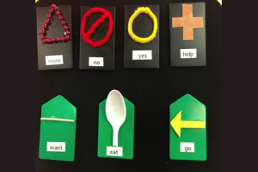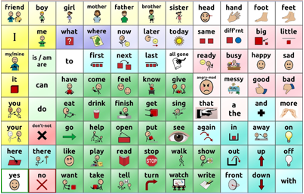What is AAC?
- Boston Ability Center
- Oct 25, 2020
- 3 min read
Updated: Feb 19, 2021
In honor of AAC Awareness Month, we're breaking down what AAC is and how you can use it to best support your child’s communication development!
What is AAC?

Augmentative and Alternative Communication (AAC) refers to all the ways in which we share our thoughts, ideas, and feelings without talking. You may know individuals who use high-tech AAC systems to communicate (like the theoretical physicist Steven Hawking), or perhaps you are the parent or educator of a child who communicates using a “talker” or picture symbols. What you may not know is that all individuals use AAC on a daily basis, whether they realize it or not!
Imagine you are at a restaurant. You are trying to get the waiter’s attention to come to the table, so you wave him over. It’s a bit loud in the restaurant, so you point to the picture on the menu to request the item you want for dinner. After you finish your food, you make eye contact with the waiter and signal that you want the check by motioning for the check with your hand. After you have paid by credit card, you write down the tip amount on the receipt. You smile and wave at the waiter as you leave the restaurant.
In this short exchange with the waiter, you used five different forms of AAC! By gesturing, pointing to a picture, signing, using written communication, and smiling, you supplemented your spoken words with nonverbal communication to better express your wants, needs, and feelings. This is precisely our goal in speech therapy when we talk about using a “Total Communication Approach” in helping children to understand and use language. Total Communication means teaching children to use a combination of spoken words and AAC to communicate with others using whatever means are accessible to them. But what exactly does AAC encompass?
AAC includes all the ways in which we communicate without using spoken language. Spoken communication involves the use of a socially constructed and agreed-upon set of symbols (in our case, the English language) to relay our thoughts and ideas. When we use AAC, we are using alternative symbols to represent our communicative message. These symbols include:
Gestures
Facial expressions
Signs
Pictures
Picture symbols
Tactile symbols
Writing
Some individuals may benefit from using AAC in the form of tools and high-tech devices. AAC systems come in many forms. These include low-tech AAC systems, such as photos, picture symbols, tactile symbols, topic boards, core boards, and communication books. If your child has ever used PECS, this is an example of a low-tech AAC system.
High-tech AAC systems include communication applications on phones and iPads, as well as dedicated speech-generating devices (SGDs). High-tech devices come in many different forms and are customizable based on an individual’s communication needs. Some individuals may use a keyboard to type out their intended message, while others may select picture symbols, words, or preloaded phrases and sentences. High-tech AAC systems have been designed to accommodate the needs of individuals with multiple sensory and mobility impairments, so even individuals with impairments in hearing, vision, fine motor, and gross motor abilities can access devices to communicate successfully.
When we think about AAC in this way, it makes sense that it not only helps children to better make their wants and needs known, but it further aids in the development of expressive, receptive, and social communication skills. When children have a difficult time producing and understanding spoken communication, using AAC can help them build their expressive and receptive vocabulary. AAC enables children to communicate their wants and needs in a way that is most accessible to them. All children, regardless of their age or ability, can benefit from the use of AAC.
Here are just a few ways in which AAC helps children to communicate. For children with severe speech sound disorders, AAC may help them get their message across when their speech is not understood. For children with a language delay, using signs, gestures, and pictures may help them develop communicative intent and build their expressive and receptive vocabulary prior to developing spoken communication. For children with a receptive language disorder, following a written or picture schedule can help them with comprehension of directions. For children with an expressive language disorder, using a speech-generating device may help them to organize their thoughts and formulate sentences in a way that is not accessible to them using spoken communication alone.
Do you want to learn more about how the use of AAC can help your child’s communication development? Call us at (781) 239-0100, and our SLPs would be happy to help!
Written by Megan Romanczyk, M.S. CF-SLP
















The explanation of AAC in this article is incredibly insightful. It's so important to highlight the different communication methods available, especially for those with speech or language difficulties. Just like how AAC helps individuals express themselves more effectively, small details in business can make a big difference in the experience. For example, using menu covers can help organize and present information in a clear and professional manner. Just as AAC enhances communication, menu covers ensure that your restaurant or business runs smoothly and communicates efficiently with your customers. Both play a crucial role in improving accessibility and service.